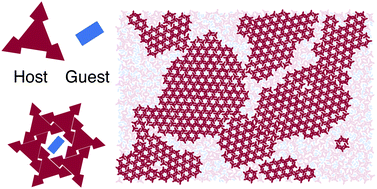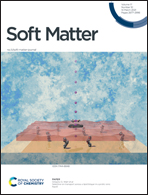Shape-driven entropic self-assembly of an open, reconfigurable, binary host–guest colloidal crystal†
Abstract
Entropically driven self-assembly of hard anisotropic particles, where particle shape gives rise to emergent valencies, provides a useful perspective for the design of nanoparticle and colloidal systems. Hard particles self-assemble into a rich variety of crystal structures, ranging in complexity from simple close-packed structures to structures with 432 particles in the unit cell. Entropic crystallization of open structures, however, is missing from this landscape. Here, we report the self-assembly of a two-dimensional binary mixture of hard particles into an open host–guest structure, where nonconvex, triangular host particles form a honeycomb lattice that encapsulates smaller guest particles. Notably, this open structure forms in the absence of enthalpic interactions by effectively splitting the structure into low- and high-entropy sublattices. This is the first such structure to be reported in a two-dimensional athermal system. We discuss the observed compartmentalization of entropy in this system, and show that the effect of the size of the guest particle on the stability of the structure gives rise to a reentrant phase behavior. This reentrance suggests the possibility for a reconfigurable colloidal material, and we provide a proof-of-concept by showing the assembly behavior while changing the size of the guest particles in situ. Our findings provide a strategy for designing open colloidal crystals, as well as binary systems that exhibit co-crystallization, which have been elusive thus far.



 Please wait while we load your content...
Please wait while we load your content...